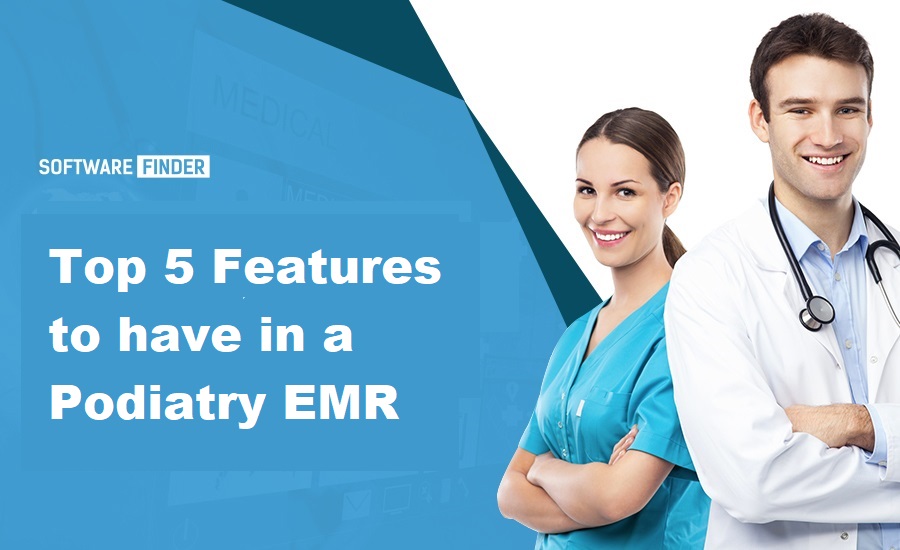
-
entries
0 -
comments
0 -
views
761
About this blog
Top 5 Features to have in a Podiatry EMR
What is an EHR?
Electronic Medical Records/ Electronic Health Software commonly known as EMR/ EHR software; EMR software has been designed to cater to the healthcare industry. EMR software is the modern way of record keeping in a clinical setting. The software helps you store medical records online and eliminates the use of extensive labor and paperwork. The software could store a plethora of information regarding multiple patients. The information could include patients’ medical history, demographics, lab reports and much more.
EMR systems come with different functions and scope. Some may cater to small practices and others might be suitable for large practices. Some might cater to a specific specialty and others might cater to a number of specialties. The software is developed by a number of EMR/EHR software vendors, each catering to different needs of a healthcare practice.
Podiatry practices like other practices have unique needs. To cater efficiently to those needs Podiatry EMR software are essential. In order to choose the best Podiatry EMR for your practice, Software Finder has shortlisted the top 5 features for podiatry EMR software that you need to look for.
Podiatry EMR Software
Podiatry practices deal with problems and conditions relating to the foot or ankle. Podiatry practitioners cater to patients of all ages. The nature of treatments could be minute to major both depending on the issue. They deal with problems like fractures, in-grown toe nails, corns, arthritis and much more. Podiatry practices have to deal with a high volume of data which becomes difficult to manage. Managing patients’ records and medical history could be a time consuming task. In order to increase the efficiency of practices using a Podiatry EMR software becomes integral.
Usually practitioners and doctors in small or large organizations feel uncomfortable and regret choosing their EMR software for the practice as they see it as inefficient and they consider it to be a hassle to use. The problem however never lies within the EMR software but the main problem is the choice. Practitioners choose EMR software that is not suitable for their particular practice. The choice of the EMR software is an integral part of the process. Similarly for a Podiatry practice, doctors should choose an EMR system that has been especially designed to cater to needs of podiatry practitioners.
Software Finder has shortlisted the top 5 features in a Podiatry EMR software users need focus on while choosing an EMR software for their practice.
Billing
Medical billing can become very confusing and difficult with high inflows of patients’ and their data. Podiatry practices use coding and billing procedures to manage efficient billing, however this could also be very hectic and difficult to manage manually. Using EMR software that has a billing module helps practices to a great extent as it allows users to generate bills automatically for patients. It also helps in saving time as it can process online payments efficiently reducing the risk of human errors. Using a billing tool helps users to speed up their reimbursement process with different insurance companies as information sharing and verification becomes automated. Automatic billing helps in managing revenue cycles, increasing revenue and also helps in overall profitability of the practice.
Patient Portal
Patient portal helps users to stay connected with their patients. It helps patients in staying connected to their doctors for any types of queries. For a Podiatry practice that is very important for example a patient with a fractured foot could easily connect with their doctor using the portal, ask for advice, share pictures, and receive electronic prescription without having to come to the practice themselves. Portal helps in eliminating the need for patients to make multiple visits. This also proves beneficial for practitioners as they can increase their capacity and cater to a larger number of patients on a daily basis.
E-Prescribing
E-prescription helps patients for easily receiving prescriptions without necessarily having to come to the practice physically. This helps practitioners to work fast and utilize time more efficiently. Writing prescriptions on a daily becomes very tedious when using a e-prescription tool this task becomes automated saving time and effort. The prescriptions are sent out to pharmacies easily, it also reduces the risk for error.
Customizable Templates
The work carried out at practices is repetitive and times consuming hence templates are a go-to as they help users to not do the same thing again and again while for example charting or storing patient information. Podiatry EMR software should offer templates that come with the option to be customized according to user preference. This allows users to work quickly be flexible and work with ease also reducing the risk for their notes to look the same. Important templates that should be included are: Bunions
- Ulceration
- Achilles
- Tendonitis
- Foot fracture
- Bursitis
- Ingrown toenail
- Heel pain
- GoutCorns
- Plantar Warts
Remote Access
Podiatry EMR software should offer cloud features supported with mobile apps and the ability for practitioner to access information easily on the go. Having a cloud based system helps users to save data in a centralized online database that allows them to access information whenever and wherever needed. This also helps in creating an online backup for data which could prove to be crucial contingency plan.
These were the top 5 features that practitioners need to keep in mind while choosing Podiatry EMR software for their practice. Visit Software Finder for more updates and professional guidance for the best EMR software for your practice.
